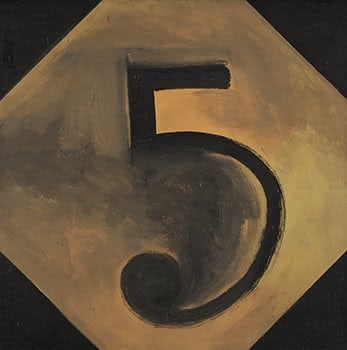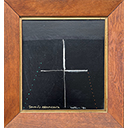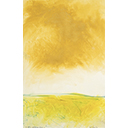Five (Russell Finnemore & Colin McCahon)
60 x 59.5 cm
est. $250,000 - 350,000
PROVENANCE Private Collection, UK Hence by descent Collection of Russell Finnemore Gifted by Colin McCahon
EXHIBITED 1965 The [65] Group Show, Durham Street Art Gallery, Christchurch 30/10/1965 - 14/11/1965
Catalogue Number cm000374
Colin McCahon had quite a thing about numbers. Five is one of at least 70 paintings in which numbers figure prominently. Numbers (or numerals - he used both terms) first entered his work around 1958 and remained an important part of his practice for the next twenty years. His initial interest in numbers came from an idea to provide designs for page numbers in the journal Landfall, edited by Charles Brasch, an important early collector and friend. The designs were never used but they led to a small series of watercolours in which his main interest seems to have been in the abstract shapes of the Arabic numbers (1, 2, 3) which he manipulated to make pictures out of. In 1958-59 McCahon made two series: Numerals One to Ten and Numerals One to Five in the medium of brushed ink on paper. In the first series the Arabic number dominates the space with the word for the number: 'two', 'six', 'nine', etc written in small cursive lettering beside it. In the second series a similar strategy applies but with the numbers painted more expressionistically and seemingly spontaneously. In these two series his main interest is in numbers as a sign system.
The next phase in McCahon's use of numbers, which includes the present Five, came in 1965 with a major series of 13 panels entitled Numerals (Auckland Art Gallery) utilising the numbers 0 to 10.
Three different forms of numbering were employed - Arabic numerals, Roman numerals and some where the word for the number is spelled out in capitals letters e.g. FOUR and EIGHT. Also in the same year, 1965, several one-off works featured either groups of numbers (e.g. Koru 1, 2, 3) or single numbers (One, Two, Four and Five).
Later works involving numbers included a study for an uncompleted mural in 1966 and several one-off paintings and series between 1974 and 1976 utilising the number sequence 1 to 14 (sometimes Roman, sometimes Arabic, sometimes both) all signifying the Christian motif of the fourteen stations of the cross. These included Walk with me, The Song of the Shining Cuckoo, Clouds, Teaching aids and Rocks in the sky.
In the case of Five (1965) an unusual feature of this work is the presence of a collaborator, Russell Finnemore, a musician and family friend. The artist invited him to participate in the making of the painting, and gifted to him the finished work. The extent of Finnemore's involvement is not known, but probably fairly minor. Clearly, the conception of the work and its structure and imagery came from McCahon.
All four corners of the hardboard square are marked off by diagonals and the triangles so formed are painted black in contrast to the rest of the ground, which is variously coloured ochre and grey. This 'corners of' device was common in McCahon's work in the 1960s. Here, the Arabic number 5, centrally placed, is painted black (like the corners) with a prominent bulb at the end of the curved portion which resembles the koru shape in Maori design. The influence of Maori design on his numbers and letters was a noteworthy feature of McCahon's work in the mid-1960s.
Is there any symbolic significance or other numerological connotations of the number '5'? In this period Christian symbolism was prominent in McCahon's work due to the spill-over influence of his use of Catholic symbolism in windows painted for a chapel in Remuera. In Christian symbolism the number 5 is associated with the five wounds of Christ, a motif which McCahon explicitly explored in a later series (1978-79). The emphasis on darkness and light in Five supports the possibility of a symbolic reading, though it is not strictly necessary to the enjoyment of this bold and striking picture, so indelibly stamped as it is with the hand of its maker.
Peter Simpson





